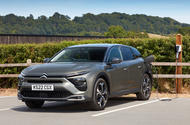Citroën has a digital nudge on its C5 X PHEV, encouraging drivers to charge more often
Euro 7G regulations mandate that PHEVs be able to switch to electric in specific areas
Buried in the detail of the new Euro 7 emissions regulations that have so incensed car companies was news of an additional category called Euro 7G specifically aimed at plug-in hybrids.
The problem with plug-in hybrids (PHEVs) is that while on paper they look like the perfect inbetweener solution on the path to pure EVs, there’s no obligation on the part of the user to actually charge the battery and thus run on zero-emission electric power. Tales of company car users choosing them to lower their tax then returning them with unused charging cables have dogged the technology from the start.
Euro 7G aims to counter that by mandating that those PHEVs qualifying must be able to switch to electric-only when the car crosses into specific geographic areas – mostly inner-city zero-emissions zones.
If there’s not enough charge to become an EV, then a “driver warning system” will sound. If that’s not obeyed within 5km (3.1 miles) from the first warning, the car will come to a halt. This is enabled by geofencing – locating via GPS.
We don’t know yet if this will affect all new plug-in hybrids when the Euro 7 emissions come into force on 1 July 2025 or just those manufacturers that wish to register as 7G.
However, Toyota in Europe has said it believes it will affect all plug-in hybrids, meaning that the PHEV experience could become a whole lot less relaxing.
Drivers, though, could be happy to accept that nudge to charge if it gains them access to zero-emissions zones, of which we’re about to see a lot more.
By 2030, 36 cities globally (mainly in Europe) aim to roll-out zero-emissions zones, according to consultancy firm Berylls Strategy Advisors. Many will be in place as early as 2025, the company predicts, with London already declaring that it aims for a zero-emissions zone (ZEZ) in the city centre by that date. If all the cities on the list, including Berlin, Paris and Rome, do roll out ZEZs as predicted, that will affect 170 million people and around 80 million passenger cars, Berylls estimates.

It’s already happening in the UK. Oxford started a pilot ZEZ in the centre of the city in February 2022 with plans to expand it further in a second phase.
The big question now is: will PHEVs qualify? “Currently, there is no globally universally applicable definition for zero-emission zones,” Alexander Timmer, a partner at Berylls, said. “In some cases, PHEVs with geofencing will probably be allowed, but there are hardly any precise regulations from the cities yet.”
Early signs are not good. Oxford, for example, said it would allow plug-in hybrids in early proposals but now says they don’t qualify: only those rated at zero grams per kilometre of CO2 can enter for free, outside of special exemptions. Green organisation the ICCT (International Council for Clean Transportation) says only pure-electric and fuel cell vehicles should be allowed.
However, Europe-based green group Transport & Environment, in a paper assessing the Euro 7 regulations, wrote: “This risks shifting pollution to outside of geofenced areas as data shows that there is a large spike in pollution after a period of zero-emission driving.”
But cities might be more accommodating if they can be certain that plug-in hybrids are being used as intended.
Some plug-in hybrids are already capable of geofenced auto switching. For example, the Range Rover Sport 510e and 440e plug-in hybrids come with something called Predictive Energy Optimisation that does just that. A large, 38kWh battery giving claimed electric-only range of up to 70 miles should cut the incidences of warning alarms.
![]()
BMW, meanwhile, has expanded the number of city centre ‘e-Drive zones’ to 13 in the UK, having launched the scheme in 2020. This encourages drivers to save their plug-in hybrid battery charge for use in city centres to improve air quality, by rewarding them with points to be redeemed at BMW-linked charge stations.
Toyota in Japan is experimenting with geofencing tech on the plug-in hybrid version of the Lexus NX SUV, while the Citroën C5 X plug-in hybrid has a digital nudge encouraging drivers to charge more.
Others have trialled specific geofencing technology, including Ford with prototypes of the plug-in hybrid Transit Custom van in London, and Fiat-Chrysler – now part of Stellantis – in Turin, Italy, with a pilot fleet of PHEVs.
Right now, plug-in hybrids are on a downward slide. In the UK, sales slipped 12% in the 11 months to the end of September, at 93,047, according to figures from lobby group the SMMT. Pure-electric car sales in the same period grew to more than double those of PHEVs.
But PHEVs remain a crucial part of the particularly premium car maker offering. Only three cars in the PHEV top 10 to the end of November in the UK were from mainstream manufacturers, with BMW the top PHEV maker in terms of overall sales.
Around a quarter of all Land Rover sales for the period were PHEVs, showing the importance of the drivetrain as a replacement for diesel. Given its improvement over diesel on tailpipe emissions, the Euro 7G badge of approval – or whatever a UK equivalent might be called – could be just the official seal of approval that the car will be used as intended.
Source: Autocar
